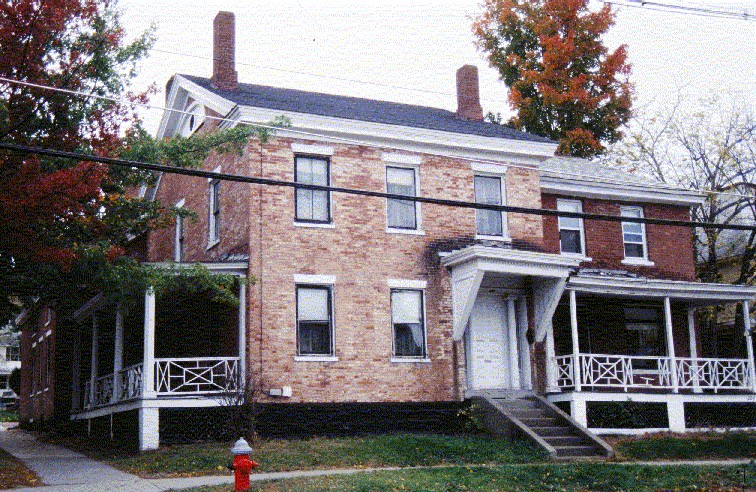




215 Maple Street/222-224 S. Winooski Avenue
(southeast corner Maple and S. Winooski)
Lois H. Coulter
Built ca 1840 with the addition of a wing by J.J. McLaughlin in 1884, this house, one of the first houses on the street, is substantially unchanged. The section known as 224 S. Winooski Avenue is the later addition. Although in the land records of Burlington, the property is listed as having frontage on Maple Street of 89.9’ and the S. Winooski frontage is only 72.25’, it is known by its S. Winooski address.1 Known as the Lyman House after one of its first owners, it is a typical brick Greek Revival style house with a limestone foundation similar in form to its neighbor across the street at 214 Maple Street. It is a two-story 3x3 bay eaves front structure with molded cornice returns. There is a 2½-story wing on the south wall creating an ell. The original roofing material has been replaced with asphalt shingles. An oversized entry hood characterizes the entrance on S. Winooski Avenue. The six-panel door with a porcelain knob is flanked by fluted Ionic pilasters and three-quarter length sidelights of etched glass. The door frame sits on a heavy sandstone sill. The hood itself is elaborately detailed with dentil molding on the projecting cornice, curved brackets and paneled truss supports. The main part of the house features radiating voussoirs over one over one and two over two sash windows. The sills on all windows as well as the lintels on the windows in the ell are plain wood. Included in the ell are three over three kneewall windows. An interesting feature of the gable end is the ocular window with its semi-elliptical surround. Porches with shed roofs and are on the north and west walls.2 They are supported by fluted columns in badly deteriorated condition and skirted with lattice. The railings have a Chinoiserie motif, perhaps reflecting the taste of the owner, Edward Lyman, a partner in the Lyman Bros. drygood business. He entered into his cousin Elias Lyman’s dry goods business in 1848 as a junior partner. By 1851, he had bought out his cousin and remained sole proprietor until he admitted his former clerk Herman W. Allen to partnership in August 1870. In addition to his dry goods business, Edward Lyman was one of the founding directors of the Merchants National Bank where he became the President.3
1 Burlington Land Records
2 National Register
for Historic Places Inventory - Nomination Form, Battery, King Street Historic
District (amendment), pp. 16-7
3 The Vermont Division
for Historic Preservation, Vermont Historic Sites and Structures Survey,
Burlington, South Winooski Avenue
![]()
Return to Church Street Corridor
![]()